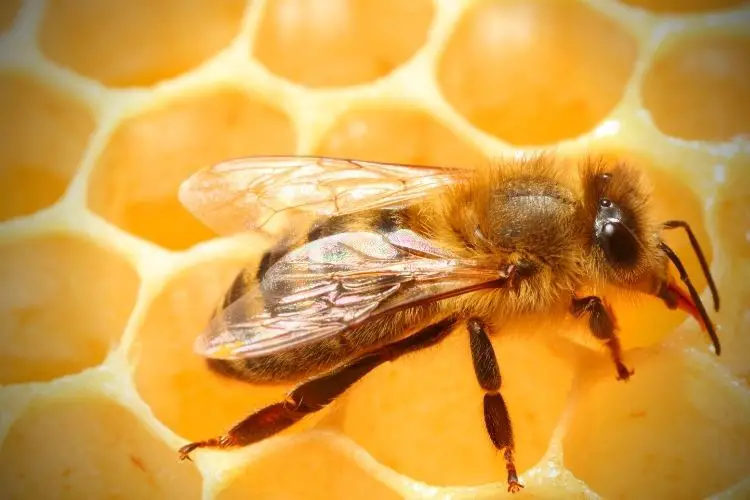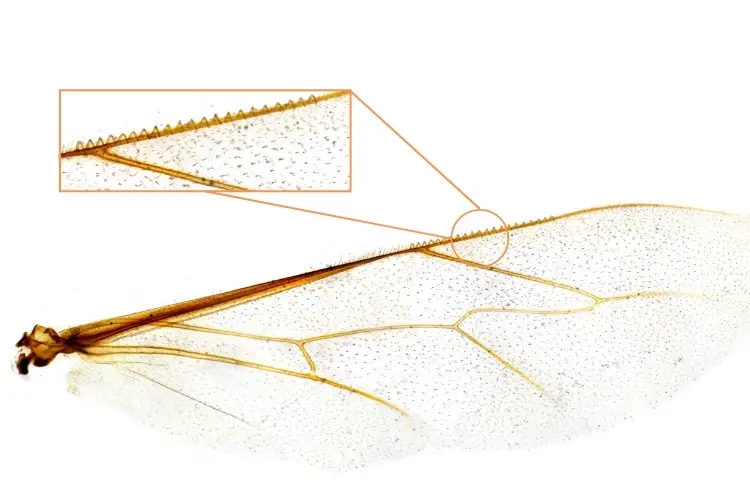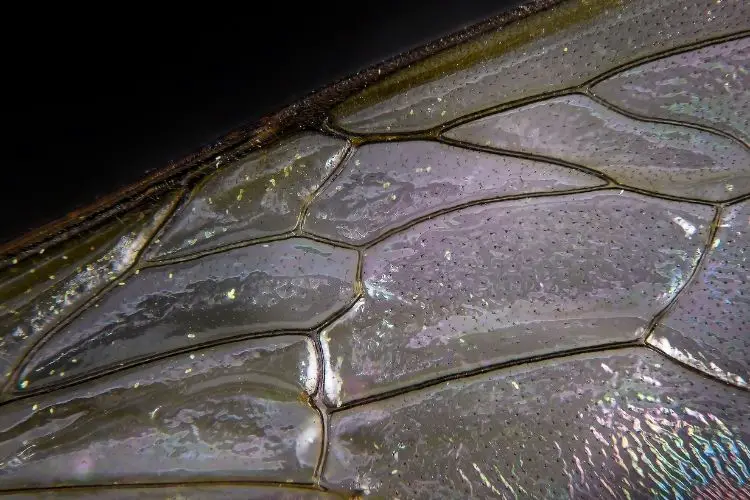Bees are flying insects from the Hymenoptera order. Therefore, their wings are similar to other insects from the same order such as wasps and ants. Hymenopterans are known for having 2 pairs of wings, and bees are no exception!
Honey bees have 2 sets of 2 wings attached to either side of their thorax. Each set has a large wing (the forewing) and a small one (the hind wing).
If honey bees have 4 wings, why does it look like they only have 2?
It may seem like bees only have 2 wings because the fore wing and the hind wing clip onto each other during flight, making one larger wing. The edges of their wings have small, Velcro-like structures that allow both wings to attach to each other, known as hamuli.
When they are not flying, the hind wing which is smaller is covered by the fore wing.

Hamuli: The Secret Of Bees’ Flight
The hamuli are tiny hooks that run along the edge of the hind wing and connect securely to the trailing edge of the forewing.
Why are these hooks necessary?
This fascinating journal article explains the mechanism and importance of the coupling mechanism, or hamuli, found in bees’ wings.
In simple terms, all insects have either 2 or 4 wings. For example, flies have only 2 wings, and bees, ants, and wasps have 4. According to researchers, those insects with 4 wings have an advantage over those with 2 in terms of list and gliding performance.
However, having 4 wings also comes with a potential downside. Whenever two airfoils (or structures meant to produce lift, like insect and airplane wings) are located next in proximity, they reduce the lift generated by the other.
Some insects with 4 wings, such as honey bees, have overcome this challenge by coupling both their wings and working in synchronized movements during flight. In other words, they become one large wing instead of 2 separate ones.
How do they couple or bind their wings to each other?
You guessed it… the hamuli.

The tiny hooks found on the front edge of the hind wing latch onto a thickened membrane on the back edge of the fore wings. As a result, the motion and force generated by the flight muscles in the thorax are transmitted from the fore wings to the hind wings through the hamuli and membrane.
In short, without the hamuli, bees wouldn’t be able to effectively generate lift and fly.
Are All Bees’ Wings The Same (Or Equal)?
All bees have 4 wings (2 fore and 2 hind wings) and share the same main parts. However, some characteristics differ among bees and their wings. In fact, for many years, researchers have used images of bees’ wings to develop identification systems that allow them to classify them according to their genus, species, and subspecies.
These identification techniques use the wings and veins to determine patterns across different bees. More specifically, they look at the points their veins meet, and assign coordinates to these points. This way, they compare the location of these points among bees and classify them accordingly.
What Are Bees Wings Made Of?
Bees and insect wings, in general, have been a subject of study for many years. It has helped researchers understand their flying mechanisms and how they can use some of their features in planes and flying structures to enhance their performance.
One area of study is how wings are structured and the material they’re made of.
So, what are bees’ wings made of?
One particular study looks into the characteristics of honey bees’ wings through a Micro-Computed Tomography (MicroCT) test. They found that bees’ wings are mainly made of multilayered membranes and veins.
The veins are cylinders with one-layered walls tightly packed between layers of membranes, so they do not form a separate structure. Instead, membranes and veins are designed to work together seamlessly rather than as individual parts, enabling bees to fly exceptionally well by flapping their wings.

Looking at the surface of the wings, the upper side (or lower side of the wing) is primarily flat with many hairs. In contrast, the inner or ventral side shows the protruding veins and the hairs on the surface.
The membrane has two main levels, or a big group of layers, the upper and lower epidermis. The upper epidermis is made by the layers forming the upper or dorsal surface of the wings, while the lower epidermis constitutes the lower or ventral side. In between both, the veins are situated like channels running throughout the wings.
Even though the wings wear off over time due to impacts or tears, these impacts are gradually peeled off layer by layer, making bees’ wings remarkably resistant.
What Do Bees Use Their Wings For?
You very likely know the answer to this one – to fly! However, did you know bees also use their wings to regulate the temperature in their beehive and transform nectar into honey?
Bees’ Wings And Temperature Regulation
Bees not only use their wings when they fly. They also have an essential role in ensuring the beehive is at the right temperature. You see, the hive’s internal temperature is critical to bees. Their beehive needs to be warm enough for the brood to develop but not too hot, so they overheat and die.
Therefore, the ability to regulate the hive’s temperature is crucial for colony survival. Whenever the hive’s internal temperature gets too high, bees use their wings to cool it down. They coordinately fan their wings, to promote airflow so some of the hot air exits the hive.
Bees also have their own version of evaporative cooling. They place water droplets inside the hive and then fan their wings to create a cold current of air.
Pretty impressive, isn’t’ it?
I wrote a whole article about bee temperature tolerance if you’d like to learn more about this topic.
Bees’ Wings And Honey
Besides cooling down the hive and flying, bees fan their wings to convert nectar into honey.
Nectar is mostly made of sucrose, glucose, fructose, and water. They use nectar to feed themselves and also to make honey. Transforming the nectar into honey allows them to keep it stored for longer without the risk of it getting spoiled or fermented. You can read more about why bees make honey here.
To transform nectar into honey, bees store this substance in their honey stomachs or crop, where the sugars get broken down by an enzyme called invertase. Then, once forager bees are back in their hive, they transfer the liquid to particular worker bees in the hive by regurgitating it and passing it on to other bees. The worker bees continue this process until the water content gets reduced from 70% to 20%.
Now, the substance is getting closer to becoming honey at this stage. However, an essential step is still missing… The moisture content of the substance needs to be reduced further so the liquid doesn’t ferment while it’s stored in the hive.
They do this by exposing the nectar to the warm temperature in the hive and fanning their wings. Hence, the hot air circulates and evaporates the remaining water in the sugar and water solution. Once the honey reaches 14%-17% water content, bees cap the cell with wax and store it until they need it, most likely, during the winter months.
Summing up
Bees have 4 wings. 2 on each side.
During flight, the hind and the fore wing latch onto each other thanks to tiny hooks called hamuli. This allows their wings to perform as one big aerofoil and be more efficient in generating lift.
Bee wings are made of multilayered membranes grouped in two main levels: the upper epidermis and the lower epidermis. In between these two levels, run cylindric veins so tightly packed that they integrate seamlessly with the membranes.
Bees use their wings for more than flying. Their wings are also essential in regulating the internal temperature of the beehive and reducing the moisture content of nectar so it can be properly transformed into honey.
